We’ve known for some time that the colony of bees residing in our neighbor’s attic is very robust. They’ve survived multiple winters without medications, or supplemental feed. However, as happens in all hives sooner or later, these bees have simply run out of room.
When bees run of out space to produce offspring, or store food, clusters of the colony are periodically ejected as swarms to make room in the hive for the remainder of the bees. By making space within the hive, and decreasing the surplus population, the new resident Queen will have room to produce new generations of offspring.
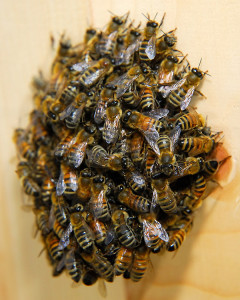
A cluster of bees on the lid of our Merrill toolbox - if you look closely, you'll see a worker with a Varroa mite on her thorax
Beekeepers spend much of their time fretting about their hives swarming. Even though most times only a portion of the colony leaves, it takes time for the population to build back up, and for commercial beekeepers this translates into diminished honey harvests.
Swarming however is a perfectly normal part of a healthy colony’s life-cycle.
The original swarm of bees we collected from our neighbor’s property on March 30th seem to be from a colony that is so crowded, and so robust, that they’re now throwing multiple swarms in an effort to get their population back down to a manageable level for the size of the hive.
On Thursday afternoon our phone rang, and it was our neighbors calling to say that their attic hive had thrown a second swarm, and that there was a cluster of bees now on the ground on the bottom branch of a rosemary bush near their porch.
When I arrived, unfortunately sans camera in my haste to get out the door, I saw a small to moderate sized beard of bees draped along the ground at the base of an old, contorted rosemary bush.
Any swarm of bees is vulnerable. They’re homeless, have only the food reserves they can carry with them, and are at the mercy of the elements, and predators. Bees don’t usually like to be on the ground, and spending the night on the ground seemed potentially risky.
It was already gone four o’clock in the afternoon, so I needed to act promptly if I was going to gather the swarm before dusk. I had an advantage however in that the cooling temperatures, and decreasing daylight were working in my favor, as the bee’s natural inclination is to cluster together before dark.
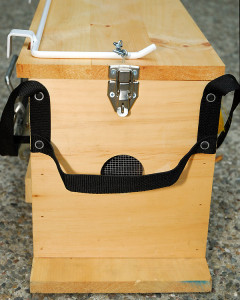
Our Merrill toolbox. Holds frame racks, bee brushes, and miscellaneous beekeeping equipment, but is vented, and can be used to temporarily hold a small swarm.
The challenge with this swarm was situating a box underneath them. However, I was fortunate in that the branch they were attached to, despite its age, was still somewhat flexible. I very carefully lifted the free end of the branch, with bees attached, as my neighbor slowly slid my empty Merrill toolbox (my beekeeper’s toolbox pictured above) underneath the bees. I then lowered the branch so it was supported by the box, and gently brushed the bees from the branch, into the box.
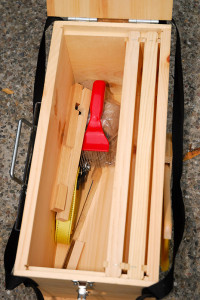
Usually the box is full of entrance reducers, hive straps, cappings scratchers and smoker fuel...not bees!
Once the majority of the bees were in the box, the box was covered, except for a small opening in the corner. I backed the box a few feet away from the rosemary bush, and pulled up a chair to wait for the stragglers to join the rest of the bees. Unlike Lisa and Robb, I didn’t have a nearby brewpub handy while waiting for the rest of our straggler bees!

The toolbox is good for keeping the bee brush handy...and seems to attract bees every time we take it outside
The bees spent the night outside on our hive stand, but locked in the Merrill box as it was too dark to hive the swarm by the time I made it home. This box isn’t ideal for swarm catching. It’s heavy, and awkward, but it is designed to hold frames, and to be used as an emergency swarm box, but in warm weather ventilation is less than ideal. Fortunately it was a cool evening, and the bees would be fine until morning.

The toolbox is designed to hold frames. Useful both for having them handy during inspections, or when capturing swarms. I think this bee is following me...
Early the next morning we set up our Nuc hive on the hive stand, and transferred the bees to their new home. As is typical of afterswarms, this was a much smaller colony of bees than the primary swarm we captured in March, approximately 20% the size of the original swarm. As a result, this colony is starting out at a relative disadvantage. With fewer bees, it will take longer for this colony to build out comb, and there are less foragers to gather food. It also means they don’t need as much space to get started, so the Nuc seemed like a better choice for now, until their population begins to recover.
There’s another element common to many afterswarms that can slow development of a new colony. A virgin Queen. This afterswarm was produced 16 days after the primary swarm. However, after collecting this swarm on Thursday evening, the hive swarmed again on Saturday morning, a mere 48 hours later.
As this hive is producing multiple afterswarms, back to back, this suggests that the hive population is still too large for the space in which they’re living.
In this situation, worker bees can delay Queen hatching. Even with multiple Queen cells in a hive, the workers may only permit one Queen to hatch at a time. Soon after hatching, the workers will shake and annoy the new Queen, preventing her from stinging her sisters, and push her out of the hive during a subsequent swarm. As she leaves the hive with her entourage this has the desired effect of decreasing the surplus hive population, but doesn’t leave the hive entirely Queenless. A few days later the next Queen will hatch, and the situation will repeat, until the hive population has decreased sufficiently. In this situation, the Queens contained within the afterswarms likely have not had a chance to take their mating flights. They are virgin Queens, and until they’ve mated, they cannot produce new worker bees. [1]
If this Queen was not yet mated when we hived her Friday morning, she will first need to take her mating flight before she will begin laying eggs. Hopefully, she’ll return from her flight safely, but it’s possible she may not. Even after her flight, there will likely be a short delay before she begins egg-laying. So with fewer bees in this afterswarm, not only are there less foragers and comb-builders, but also potentially a Queen who won’t be egg-laying for a while. Compared to the primary swarm we captured in March, this colony is thus at a significantly greater disadvantage. However, it’s spring, the flowers are in bloom, and there are quite a few drones about at the moment, so hopefully this colony will be Queen-right soon, and the hive will thrive, but we’ll need to keep a close eye on them until we see evidence of brood.
In the meantime, the third swarm Saturday afternoon was housed by another neighbor whose bees did not survive this last winter. It’s quite likely the parent hive will continue to produce more swarms this spring, as new young are produced, and the population increases again. Hopefully any remaining swarms will find suitable habitat in the trees nearby, and thrive.
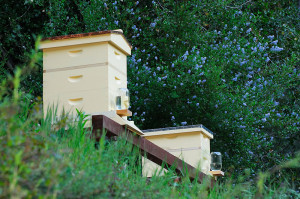
Home Sweet Home: with two additional hives of bees on the way, our hive stand is going to get a little crowded! At least the Ceanothus is in bloom though, and bees LOVE Ceanothus.
If our new Queen doesn’t show evidence of being appropriately mated within a couple of weeks, we may, for the sake of the remaining bees, either re-queen this Nuc, or combine the workers with their thriving sisters in the Salvia hive. For now though, we’re giving this hive the benefit of the doubt, and we’ll see what transpires in the next few weeks.
————————-
[1] Seeley, Thomas D. 2010. Honeybee Democracy. Princeton University Press. p. 40-42

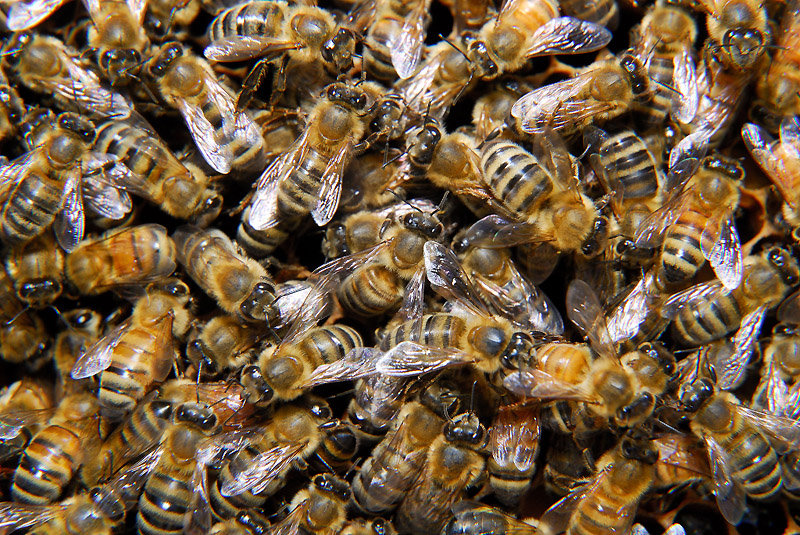
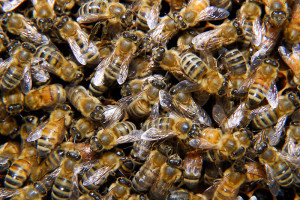
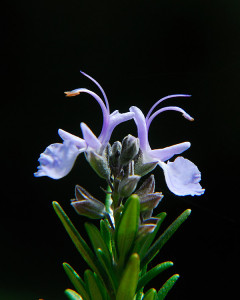
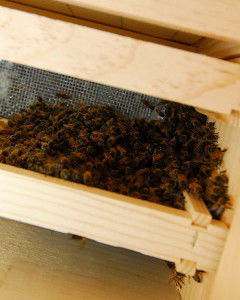









Great post. Really interesting. Hope the bees settle in happily
I hope so too! 🙂
This is a really interesting post and you really know your subject! I hope your girls figure it out and settle down. At some point I’d love to get some hives too, so I scare the neighbors with the crazy bee outfit. Bees are fascinating and need our support for sure.
I swear, for the first week we had bees, every time I stepped outside my neighbor was driving by. I probably scared him. It’s difficult not to look like you’re responding to a hazardous situation when you’ve donned your full bee suit and gloves! 😛
I love reading about your beekeeping adventures.
Thanks for stopping by Kave, I’m having fun living our beekeeping adventures! 😉
You’re going to have to get some more hive bodies if you keep on taking in swarms! I put our bodies together today. Now I need to get them painted, which may have to wait a bit because rain is forecast every day this week! Took me a bit but I found the mite. I am quite happy looking at your bees until ours arrive. 😀
The mite was quite fuzzy. I didn’t see it until after I downloaded the photo, so you did well to find it! We are going to need yet more hive equipment. Stocked up on one extra hive after the first swarm, and now we need yet another! It’s been drizzling here too. I’m just hoping I can get one more hive painted before the bees we ordered show up! 😉
I didn’t know bees have such a dramatic life. Swarming, virgin Queens, spending nights outdoors, thanks to your posts, I have a new appreciation for bees.
The more I learn about bees, the more fascinating I find them. Their society is truly complex, and drama filled! All this, and they haven’t made any honey yet! 😛
I am fascinated by bee adventures and doings. Also by how you can tell what is going on in the hive with social interactions. I don’t think I could be as brave as you to rescue them, but being allergic does not help.
Fortunately, many have studied bees and bee behavior long before we acquired bees, and written it all down! It’s also good that we like to read 😉 Bees really are intriguing though, and I’m grateful I’m NOT allergic, although none of these bees have stung me…yet!
Wow! I knew bees swarmed – and that was about it. Such interesting information about why. I hope the new queen completes her mating so she can rule over the new swarm.
Although I don’t think we understand all the reasons why bees swarm, as new beekeepers it’s important for us to know they do, and what the common causes are. The most common reason is the colony simply doesn’t have any more room to expand. I hear of a lot of newer beekeepers who lose their hives to swarming because they didn’t realize the bees needed more space. I’m looking forward to seeing how this Queen works out too!
Any idea which bees swarm with the new queen?
The workers who had been attending her in the old hive?
Bees who have had enough of some of their sisters?
Youngest?
Most experienced?
Best pollen hunters?
Closest to the hive entrance?
They’re clearly the risk takers – venturing out leaving behind the security (and honey) of their old home.
From what I’ve read thus far, swarms are usually composed of bees that are a mix of ages. It does seem that the scout bees in a swarm, those tasked with finding new real estate, are usually ‘retired’ field workers, and therefore some of the oldest bees in the colony, but the rest of the bees are a mix. This makes sense, as a number of tasks will need to be divided among the workers once they find a new home.
In the first primary swarm we were surprised how many drones were tagging along too. I’m sure for some bees they probably just get caught up in the excitement on the way out of the door.
I do know that the straggler bees, the ones we wait for after the bulk of the swarm is boxed, if they don’t make it in the box with the rest, they often will return to the parent colony. I suppose this must mean that following the new Queen out the door isn’t considered treason! 😉
I really wonder what your neighbors attic looks like to have so many bees swarming. This is so interesting. The Ceoanthus blooming behind the hives is so pretty! I bet they do love it.
I’ve asked the neighbors if they’ve seen honey running down their walls, but so far they haven’t 😉
I hope too that the new swarm will survive on it’s own. I have always wondered about swarms and if they had a Queen. What about the drone? is that a bee from a different hive altogether that she seeks out?
Swarms do usually have a Queen. If they lose her very soon after swarming, I think most of the workers would return to the parent hive.
It’s my understanding that drones from various hives sort of hang out together, some distance from their hives, and know how to find the Queen on her flight. Even though there are drones in the hive, I’m sure that the mating flight helps to reduce the likelihood of inbreeding. She may mate with up to a dozen or so drones on a single flight. Mating with only one or two is less optimal, and can result in a poorly mated Queen if she ends up mating with her ‘sons’. That may happen toward the end of the year when less drones are hanging around.
Hi CV,
Amazing to see all the Bees, I do hope the swarm gets going and that the Queen mates and begins laying for you soon 🙂
This post was a really fun read! I’ve been gobbling up all the bee keeping posts I can in hopes of someday having a hive. Thanks for posting it!
I spent last year reading tons of bee blogs, and for me I found it really helped. Everyone has their own beekeeping style, so the more you read and learn from other beekeepers, the more you realize there’s more than one way to keep bees. Which is great, as there are a lot of choices to be made when you have bees and it helps to have an idea of how you’d like to keep them before your first swarm arrives! 😛
I don’t understand why the possibly queenless swarm doesn’t just join the other box? Will they simply die off without a queen? or go out on their own to find new living quarters? I, also, can’t imagine what the attic must look like!!!!
I’m curious to see that attic too! 😛
This swarm by all appearances has a Queen. Without one, I doubt they’d stay in the Nuc hive. However, until the Queen is mated, there’s risk their population won’t be able to replace itself. In those situations, yes, most may die off. Some may succeed in ‘drifting’ to other thriving hives though, but they have to get past the Guard Bees at the entrances of other hives. Bringing food, like nectar and pollen, some workers may be able to bribe their way in.
During a swarm, if the workers leave with a Queen, and let’s say she’s immediately eaten by a bird, they’d probably fly back to the parent hive from whence they came by the end of the same day. Once they’ve been away from the parent hive for some time though, they’d likely be viewed as intruders if they return.
They are dependent on the Queen for a thriving colony though. Without a Queen, they can’t make a new Queen. Although in rare circumstances a worker bee can lay an egg, that egg can only ever be a drone (male) as it’s not fertilized. Only Queens can make worker bees (females) and produce the eggs that become new Queens. Worker and Queen eggs are always fertilized. There’s definitely substantial risk for any bees when they swarm. Their best chance for a thriving colony is to find a home quickly, and have a Queen that is well mated.
Three beekeeping households in one neighborhood! Wow. Fascinating and informative post again. Thanks!
Our neighbors who hived the third swarm have tried keeping bees the last two years (from packages or purchased Nucs) and lost their bees both years. They’re hopeful that bees from this feral colony will improve the chances of the bees surviving, as are we. The neighbors with the bees in the attic used to be active beekeepers, now I think it is they that are kept by the bees 😉
Once again Clare thank you for the extremely informative post on your new bees. I’m learning so much through your efforts and looking forward to how the hives progress over the summer.
You’re welcome Marguerite, I’m learning a lot from the bees, although I still have an awful lot to learn! I’m most curious at the moment to see how this new smaller swarm does. I almost wish I could fast forward through the next few weeks 😉
Simply amazing!! Thank you for the great explanations, and what an amazing creature. We had a few bees in our house this week. Random 2 bees each day for the week, and I looked at them completely differnetly since you started posting. Thank you!
Oh, I wonder if you had scout bees looking for a new home? 😉
Oh, that mite. Yikes.
Here is an amazing bee story. We drove up to Saratoga for me to give a presentation. We were driving down a busy, busy road and when we stopped at a light I noticed about a dozen bees flying around our car. Then we looked at the car on our left and there was a swarm of thousands holding on to the taillight. As the light changed and the car began to move the bees returned to the swarm and held on. The car was in front of us going about 30 mph…last glimpse the bees were still holding on!!! Hurrah.
Sharon Lovejoy Writes from Sunflower House and a Little Green Island
Even though I know Varroa destructor is ubiquitous in honeybee colonies these days, I agree…that mite…ugh! It was only two days before I spotted the first mite in the larger swarm colony. They’re definitely there, the question is how well can these feral bees cope with them? I presume fairly well as this robust colony made it through winter.
I can’t imagine seeing a swarm speeding down the road clinging to a tail light! It’s a shame you didn’t have a video camera handy, that would really would have been a sight to see! I wonder where they ended up? Usually they don’t venture too far from where they originated, but these bees sound like they were very well traveled! 😛
I am awed by those who keep bees. I am allergic, so we’ll not be one of those.
I’m sorry you’re allergic Nell Jean. Honestly, if I was allergic, I’d probably still be stubborn enough to keep bees 😉 Of course, it would have to be full bee suit, and keeping an Epi-pen handy. I’ve actually read of a few people who are allergic, or who have developed allergies to bee stings later in life, still keeping bees! I’m sure your lovely garden though attracts enough bee visitors without you having to maintain a hive of your own. 🙂
Clare, it’s been really interesting, all these chapters in the story, I’m always pleased to see another bee post and feel like you’re taking all your readers along for the ride, bumpy and all. Heavens, what must that attic bee like? I can’t imagine..do they harvest the honey from there?
I think, based on the roof line, that the bees actually only have access to a portion of the roof that is adjacent to their chimney. It could still be a substantial colony though. The owner who used to keep bees though has discovered he’s developed an allergy to bee stings, not uncommon for former beekeepers who have been away from beekeeping for a while. Until there’s a real problem, like honey dripping down the wall, he plans to leave the bees be, happy to let them reside in that part of the attic, and come and go as they please. This way he can enjoy the bees in the garden, but not have to handle them directly. We’re very grateful that he’s allowed the bees to stay, and have the time to work themselves up into a very strong colony. It will very interesting to compare these bees from the swarms, to the bees that we’ve ordered. We suspect the bees we’ve ordered will be considerably weaker, and much less likely to survive winter.
Incredible! My neighbor has a hive and I am SOO careful to keep wonderful things they might like, in my gardens. And of course ORGANIC!!
If my husband were not allergic to bee stings, I would love to keep bees myself!
I love that you’re so considerate of your neighbor’s bees. We’re fortunate here to have fellow beekeepers as neighbors, that understand the importance of not spraying toxins in their gardens.
You know, even though your husband is allergic, if you really wanted bees, you could still have them. A number of beekeepers in our local guilds keep bees, but don’t keep them on their own property. Either a family member or neighbor is allergic, or the city doesn’t permit hives within the city limit. A number of people have gardens or small orchards, who would be a happy to host a hive for you. You would have to do the hive maintenance, but keep the bees on their property. They’d reap the benefit of pollination, and maybe a jar or two of honey in return in late summer. Being off site, you could enjoy your own bees, and your husband wouldn’t have to encounter them personally…although he might still need to like honey! 😉
Fascinating! Fascinating! It’s like reading about another culture! I have come to see chickens and bees with a fresh perspective thanks to your incredible blog!! :o)
I love the last photo, with the oh-so-neatly-painted hives in front of the ceanothus.
Is the supplemental nectar just plain sugar water? or does it have something extra in it?
Does an established, healthy hive need to be supplemented year ’round in this area? or just seasonally? (I assume supplying it now aids the initial settling in.)
Ha! I’m sure after their first winter, our hives won’t look quite so neat and tidy 😉
The nectar is just a 50:50 blend of sugar and water. I refuse to feed corn syrup, and would prefer not to feed the bees at all. Honestly the first hive was so robust that I may have been able to get away without feeding. However, we didn’t have much drawn comb to give them. As most of what was available was just wax foundation, and comb building is energetically expensive for bees, we opted to feed while they build out comb. There are supplements, like Honey-B-Healthy that can be added to nectar, but we’re not using them at the moment, as they can make the nectar more attractive to robbing bees and insects. It’s also early spring, and there’s lots of other food around, and I think natural food is simply better for them.
In California we go through a late summer dearth of blooms, where there is a paucity of available natural pollen and nectar. A hive that is light, perhaps a late season swarm, that hasn’t built up enough stores, may need feeding during the dearth. Here most of our plants are native, and will go dormant by August. We’re planting some friendly exotics, like lavender and rosemary, to help extend our bloom season, but it still may not be enough.
The most important time to consider feeding is late winter/early spring. Some local beekeepers lost hives to starvation during our late wet March as the bees started building up population in the nice weather in January, but couldn’t forage for most of March, and ran out of stores. Feeding during that time may have helped the colonies survive until they could forage again.
The best way to reduce the need to winter feed your bees though, is not to take too much of their honey in summer! Their own honey is hands down the BEST source of food for bees. 🙂